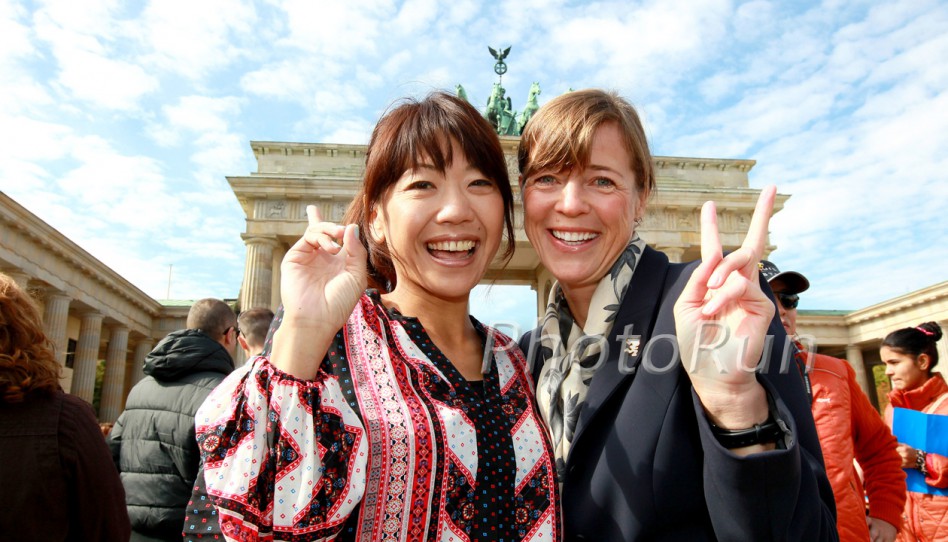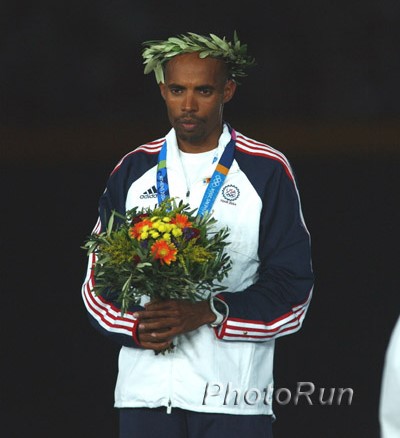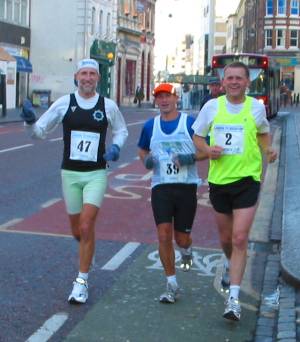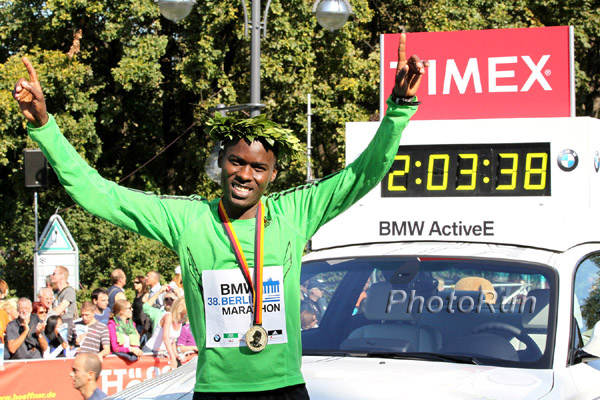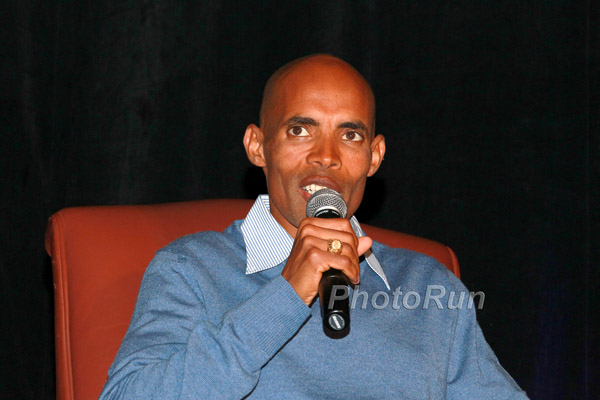Believe, Believe, Believe: Billy Mills’ Own Story—from Desperation to Winning Gold

On the starting line of the 10,000m final at the 1964 Tokyo Olympic Games, U.S. Marine Corps lieutenant Billy Mills was just another runner. Neither the press nor his fellow competitors expected him to do anything other than run a decent race and finish in the middle of the field. A medal for this young Native American from South Dakota was just a dream.
But then Billy stunned the running world.
In one of the most amazing moments in Olympic history, this 26-year-old underdog ran nearly a minute faster than he had ever previously run a 10,000-meter race. In the last lap of the still-celebrated race, Billy managed to stay with the leaders, but became boxed in and was then ultimately dropped in the final stretch. Undeterred, Billy went wide and put on one of the strongest finishing kicks in Olympic history—to break the tape first and win the gold. It was the first and only Olympic 10,000m gold medal ever won by an American, or even a runner from the Western Hemisphere.
Before this magical moment in Tokyo, Billy had been living a very difficult life. Orphaned at the age of 12 and living on the desolate Pine Ridge Indian Reservation, he struggled as he grew up—until finally, through the stewardship of his family and mentors, he discovered his true passion: running.
Billy now works with his charity, Running Strong for American Indian Youth, and speaks to groups throughout the world about the lessons he has learned from his incredible life. He is happily married to his wife of 48 years, Pat Mills. Take The Magic Step® writer Duncan Larkin spoke with the man who beat all the odds. *We have included a special first-person section at the end of the interview, in which a very emotional Billy reveals some astonishing details about his troubled past and how close America came to losing this legend before he achieved his celebrated gold medal.
Tell us about your charity, Running Strong for American Indian Youth.
Billy Mills: I am very proud because we started this charity from nothing and we’ve been able to raise over $100 million. So many people have joined together to make it a success. I’ve even been able to work with a friend of mine, the great African runner Kip Keino. He founded a children’s home in Nairobi, Kenya and I wanted to help him. So we met several times with his wife, Phyllis. We then formed Christian Relief Services under Eugene Krizek, who then formed Bread and Water for Africa under Phyllis, which helps Kip.
We put a lot of effort into helping youngsters. We help them have a stable life with the infrastructure and surroundings that perhaps most of us take for granted. Those simple things can make such a difference to the development of a boy or girl. We also try to encourage young athletes, providing them not only some coaching advice, but also the mental confidence for them to achieve their dreams. Fitness, nutrition, and a healthy lifestyle—these are all part of what we try to instill in the children, with the goal that they will develop into positive confident adults.
Although our charity has Youth in the title, we also try to help all Native Americans. We are working with the infrastructure on the reservation. For example, we recently joined forces with a Mohawk Indian named Tom Cook, who was building an organic garden on the reservation. We took Tom’s idea and expanded it, creating organic gardening opportunities for many more people. We also created two dialysis clinics. One was at Eagle Butte, South Dakota and the other is at Pine Ridge, South Dakota. We’ve also help fund one other dialysis clinic. And we’ve helped the elderly with emergency heating bills. We use a multitude of operations to build up the infrastructure as a means of trying to empower American Indians.
When you work with young runners what advice do you have for them?
Billy: I’ve never, in a sense, strictly coached a youngster. I might give them some training tips, but what I really try to do is give them the mindset to accomplish their goals. Their world is different than it was in my time in running. But I try to use myself as an example. I describe the hard work, how I faced and overcame obstacles, and the success that followed, to inspire them to go for their dream. The youngsters look up to me for what I accomplished, and I try to use their belief in me and transfer it into a belief in themselves, sprinkled with whatever training advice I think will help them.
I usually tell them not to neglect developing turnover and speed. There should be some form of speed work in their program. But mostly I try to work with them more from a psychological standpoint. And I use my own history to hopefully inspire them.
My fiercest competition was always myself. If I could reach into the depths of my capabilities and perform to the greatest extent I was capable of on a given day, based on proper preparation, that’s all I could ask of myself.
I try to get this across to young athletes to make them understand that they must look within themselves—not at their fellow competitors—for their dream. And when they do that, they are going to get the most out of themselves based on their training, and talent.
I think this advice can fit well into any program—whether it’s high school, collegiate, world class, or even just recreational exercise—to achieve a more quality lifestyle through fitness.
If you could give one piece of advice based on what you’ve learned during your incredible life what would that be?
Billy: I would say that it’s the journey that’s important, not the destination. The daily decisions you make in life, not the talent you possess, are what choreograph your destiny. Ultimately, it’s the pursuit of excellence that takes you to victory. When you find that passion, it allows you to focus. In my Native American world when you are focused, then the body, the mind, and the spirit all work as one to motivate you to discover and achieve your dream.
People make a big mistake when they say, “I need to be motivated.” You motivate yourself. I might inspire somebody, but that person has to be motivated within themselves first. Look inside yourself, believe in yourself, put in the hard work, and your dreams will unfold.

After you won your gold medal did you feel that everything would be easier? What did your accomplishments teach you ultimately?
Billy: I think what it taught me was that you have to find a passion in life. My Dad always told me in simple ways, “Follow your dreams. Every dream has a passion. Every passion has its destiny.” What I’ve taken from my dad and my high school coach, Tony Coffin, and other people who’ve guided my life is something that I’ve shared with young people over the years when I talked to them; it’s not about how to be a better athlete, it’s about how to be a better person. My Dad would always tell me, “Know yourself and find your desire.” And with desire comes self-motivation. And with motivation, then comes work. And with work comes success.
Where did you find your next passion?
Billy: When I ended my career as a world-class athlete, I realized that I had to find something new to be passionate about. Whatever you pursue in life after you have had success, society expects you will achieve equal heights of success. If you don’t find another passion, you are going to become very frustrated. I actually found a passion in the insurance industry. It gave me the chance to help fellow Native Americans to make their lives better and more secure. That made me feel good. It was much different from the international success that I had achieved, but emotionally it was very rewarding and satisfying. It gave me another opportunity to address Native American issues as my way to give back, which was the movie “Running Brave.” After the movie came out, I was asked to continue to give. So I met with Eugene Krizek and we started Running Strong for American Indian Youth.
I then had an opportunity to write a book with Nicholas Sparks called “Lessons of a Dakota.”
And all these wonderful things almost didn’t happen because initially, I became very frustrated. People just assumed I would become the best insurance agent in the world due to my winning a gold medal. But I fell back on my philosophy: Look inside yourself, don’t look to others, work hard, and you will find success and happiness.
That philosophy allowed me to successfully transition from the gold medal to a full, meaningful life.
As you get older, when you look back on your gold medal win in 1964, does that moment seem to fade, or is it still vivid?
Billy: Twenty years ago, I used to go jogging alone on a bike trail. Picture this: I’m at a slow jog. I’m by myself. Subconsciously, where does my mind go? My mind goes back to when I am training for the Olympics. I suddenly realize, “Oh my God, I’m living in the past.” So I went to a friend who is a psychiatrist and he said, “No, you are not living in the past, but you have built that key event in your life into your subconscious mind very powerfully.” He advised me that to override the subconscious thoughts of living in the past. I should replace it with something more powerful in my subconscious mind. And I did.
Since then I realize that I still need to keep these thoughts about the beauty and sacredness of the Olympic games and let them grow to a greater maturity. I am 71 now, and when I walk by myself I think about the wonderful journey of life and how precious it has been. It’s been such a beautiful, beautiful journey.
—
*Finally, Take The Magic Step asked this remarkable man to recall some of the experiences that shaped his life the most and helped to mold him into an Olympic Champion. Billy spoke so emotionally and passionately that we have included the entire first-person special section below in which Billy takes the reader on a very poignant journey.
I was heartbroken when my mom died. I was 8 and my dad spoke to me in words I couldn’t understand then. “Son, you have broken wings—but some day, you’ll have wings of an eagle.” Through my tears I saw him take a stick and try to draw a circle with it in the ground. I remember him saying, “Step inside the circle and close your eyes,” which I did. He asked, “How do you feel?” I was just a kid and I couldn’t respond. “What do you see?” he asked. I still couldn’t answer him. He clapped his hands. Boom! And I remember shaking with my eyes still closed. He said, “I’ll tell you what you feel; I’ll tell you what you see.” He said, “You feel anger and pain.” He told me that I should expect that, because I just lost my mom. He said, “You probably feel some hate, because people have expressed hatred toward you. Jealousy, because you don’t have anything of material value. But the jealousy blinds you.” He said, “You don’t see the virtues or the values of our culture, of other cultures. You don’t see the good in people. You have a whole lot of self-pity.” He said, “All these emotions will destroy you.”
Then he hugged me and said, “Son, you have to look deeper—way down deep, below the hurt, the anger, the hate, the jealousy, the self-pity, because that’s where your dreams lie.” He continued to talk this way to me until I was twelve and he passed away when he was only 49. He said, “You have to look so deep for the dream, until something miraculous happens to you and you get to know yourself. There’s only one destiny greater than the destiny we choose for ourselves and that is the destiny our creator chooses for us.”
My junior year of college I came so close to committing suicide. It was at a Cross Country Championship meet. During the photo session I was asked to step out of the shot. I had been asked to step out of photos before then, at least three or four times. At the time I thought it was for racial reasons. And so that time I broke. It was the whole conglomeration of incidents that caused me to break down. It was a fatigue of circumstances that had happened to me. I didn’t have the maturity to work through them. I didn’t rationalize why I was asked to get out of the picture; I didn’t understand that there could be other reasons besides racial for it. I just knew it was time to give up. And so I stayed in the picture, but I went back to my room and decided to commit suicide.
I’m on a chair and I’m going to jump. Somehow I heard my father speaking. I didn’t hear it through my ears but it was in my skin. “DON’T. DON’T,” he was telling me. It was like, wow. I believe my Creator sent my dad’s voice to me. I got down off the chair. And something made me reach for a pen and write down these words: “Gold medal. 10,000-meter run. BELIEVE. BELIEVE. BELIEVE.” And right there and then I started training for the games.
Flash forward to a few years later. It’s October 14, 1964 and I’m coming off the turn on the Olympic track in Tokyo. In the lead is the favorite Ron Clarke, the world record holder from Australia, then Mohammed Gammoudi of Tunisia and then me. And I’m hitting low blood sugar. Three hundred yards to go and I consciously decide to let them get maybe 10 yards ahead of me. In the past, every time I’d felt this low blood sugar and seen somebody make his move 300 yards out I’d gone with him—only to fold in the finishing sprint. So I made the decision to let them go ten yards up on me. I decided I would wait for the last 120 yards and try to catch them. So here we are, coming off the final curve in Tokyo. There are more than 75,000 screaming people in the stadium but all I hear is the drum of my heart. Clarke and Gammoudi are running neck and neck. I’m eight yards behind them. I’m six yards behind them. And then I’m only four yards back. I’m thinking, “Now, I’ve gotta go … see if I can last until the finish.” But this lapped German runner, moves in front of me so I’m boxed in. A thousand thoughts went through my mind in the last 100 yards. First, “Can I go inside?” I can’t because of the lapped runners in the inside lane. I have to go—and I’m thinking that that might cost me three or four yards. All of sudden, the German must have sensed me coming because he moved out into the fifth lane. Wow! It opened up the fourth lane to me.
And I was just saying to myself, “NOW, NOW!” As I go by the German runner, I see out of the corner of my eye the eagle—the emblem of Germany—on his singlet. And I get a flashback to my Dad’s words—”Some day, you’ll have wings of a eagle.” I knew in that instant that I could win. I COULD WIN! But Clarke and Gammoudi are still ahead of me. In the last 30 or 40 yards, I had a momentary thought that it was not going to be humanely possible to catch them. But I told myself, “Believe! Believe! You have to do it now.” I must have thought a million times that I may never be this close again to winning a gold. I surged like I was on eagle’s wings … and I felt the tape break across my chest. I’d won the gold medal, running almost a minute faster than I’d ever done before. Gammoudi took silver and Clarke the bronze.
Now, here’s the strangest thing. Afterwards I look for the German runner—and see there’s no eagle on his chest. But when he’s putting on his warm-up jacket, there’s the eagle of Germany on the back! In the Native American tradition, the eagle takes messages to God. So it’s almost as if God heard my wish, my desires, my passion. I felt that that moment was a gift to me—a gift to me from a higher power.
I look back as a 71-year-old man today. I came so close to committing suicide. I came so close to being destroyed by anger and hatred. I lived in poverty. But it goes back to my wife, Pat, my dad, back to my mentor Tommy Thompson Sr., the Naval Academy running coach, back to my high school coach, Tony Coffin, back to my brothers and sisters—back to the people who gave me direction. That direction gave me hope. To put all the inspiration from these people in perspective, however, I have to say that the most powerful and influential person is my wife, Pat. Without her, there’s no way I would have won a gold medal in the Olympic games. There’s no way I would have had a successful business. And who’s to say, perhaps there may have been another suicide attempt.
A lot of this didn’t settle in until seven years ago when I ran a 5K fun run on New Year’s Eve and not only my daughters but my wife Pat beat me! And they were waiting for this old guy with bad knees to come in. When I finished, we went and had breakfast. Next morning, Pat told me, “I’m through raising you.” “My God, she’s going to divorce me,” I thought. Instead, she said, “I supported you in your passion to win a gold medal. I helped you in our passion to build a nice, successful business. It’s time for me to go back and pursue my passion.” So she went back to school and got her master’s degree in art. She went to Paris and studied in Monet’s garden for a month. If you get a chance, go to her Web site: www.studiotupos.gallery. Tupos is a Greek word that means ‘impression.’ She does beautiful, beautiful work. She’s out pursuing her passion and I carry her paint and paintbrushes for her. She’s teaching art on some cruise ships. And now I’m her assistant. But you know what? I am the best assistant I can be!
- Posted May 28, 2010
© Copyright 2010-2024 by Uta Pippig. All Rights Reserved.
